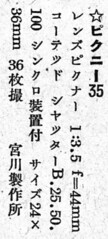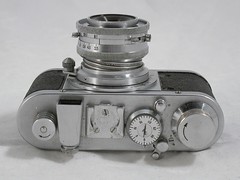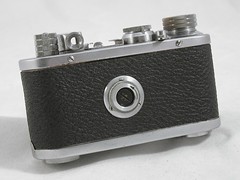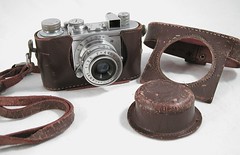Picny 35 and Royal 35

|
| Picny 35 by Marcus Ziegler. (Image rights) |
See also the later Royal 35 rangefinder camera, which was made from 1955 by Royal Camera and was probably unrelated.
The Picny 35 and the Royal 35 are Japanese cameras using 35mm film, made around 1951 by Miyagawa Seisakusho. These cameras are evolutions of the Picny B, an earlier model using Bolta film. The Royal Senior is a related camera, taking 4×4cm pictures on 127 film.
Contents
General description

|
| Picny 35 in Photo Art January 1951. (Image rights) |
The Picny 35 and Royal 35 have an aluminium body with rounded edges, similar to that of the Picny B.[1] The lens and shutter assembly is mounted on a telescopic tube. The tubular viewfinder is offset to the left, as seen by the photographer. The film is advanced by a knob at the right end of the top plate. The exposure counter and rewind unlock lever are placed next to the advance knob. The button at the front looks like a shutter release, but it is actually used to unlock the film advance after each exposure — the actual release lever is on the shutter casing itself. There is an accessory shoe between the exposure counter and the viewfinder. The rewind knob is at the left end of the top plate.
The bottom plate is removable for film loading. It is locked by a key on the advance side, with O and L indications (for Open and Locked), and has a tripod thread on the opposite side. The back is fixed, and has a large screw in the middle, moving the pressure plate back and forth for easier film loading. The screw hole was probably used to set the infinity focusing during assembly or repair.
Three main versions are known: the unit-focusing Picny 35, the front-cell focusing Picny 35 and the (front-cell focusing) Royal 35.
The unit-focusing Picny 35
The unit-focusing Picny 35 has a helical tube which unscrews to the infinity position, attached to a focusing mount driven by a tab. The distance scale is in feet, from infinity to 2ft.[2] The lens is a Picny Anastigmat 44mm f/3.5 and has no serial number. The shutter is of the setting type and gives B, 25, 50, 100 speeds. The speed is selected by the frontmost ring of the lens barrel. The shutter setting lever and release lever are placed behind. There is a thread for a cable release on the side, and a synch pin at the bottom (which is broken on the example pictured below). The aperture ring, graduated from 3.5 to 11, is placed further behind.
The Picny 35 is briefly mentioned in the January 1951 issue of Photo Art.[3] There is no picture, but the range of speeds indicates that the document refers to the unit-focusing version. The camera is attributed to Miyagawa Seisakusho, and the lens is mentioned as a Picner (this was the lens name used on the Boltax and Picny B).
  
|
  
|
 
|
| Picny 35, unit focusing. Pictures courtesy of Marcus Ziegler. (Image rights) |
Various surviving examples are known, only differing by minor details. The camera pictured above has an arrow on the advance knob, and an accessory shoe attached by three screws. It has no name marking, except for the Picny embossing at the front of the leather case. The camera pictured in Sugiyama is similar but has a Picny 35 engraving offset to the right, in front of the exposure counter.[4] At least one other camera has the same marking in the middle, no arrow on the advance knob and a shoe attached by two screws only.[5] Some cameras have the words MADE IN OCCUPIED JAPAN engraved on the bottom plate.[6]
The front-cell focusing Picny 35
At least one example of the Picny 35 is known with front-cell focusing.[7] It differs from the above model by a number of points. The helical is replaced by a collapsible tube made of polished metal. The exposure counter and advance unlock button are different. Finally, the arrow engraved above the advance knob has a different shape.
The lens is a front-cell focusing Picny Anastigmat 45mm f/3.5. The distance scale is in feet, from infinity to 2ft. The shutter is a Balnet (B, 1–200), synchronized via a horizontal pin at the bottom. It has a setting lever at the top and a rather long release lever on the side. The name BALNET is engraved on the rim in fancy letters, as on the synchronized shutter mounted on some Baby Balnet cameras. The aperture scale is placed above the shutter casing and goes from 2.8 to 25, despite the maximum aperture of the lens.[8] It is likely that the shutter was not originally designed for the camera. It was maybe replaced at some point, or the camera may be a prototype assembled by Miyagawa from various parts.
The Royal 35
The Royal 35 is only known from a picture in Sugiyama, where the camera is called "Royal-35 I" and attributed to "Royal Camera Works" for an unknown reason.[9] The main body is the same as on the front-cell focusing Picny 35, including the controls on the top plate. There is a larger rectangular plate screwed to the front, and the base of the telescopic tube is heavier. The name 35 ROYAL is engraved on the front plate, on the advance side.
The lens is a front-cell focusing 50mm f/3.5, reportedly called Royal Anastigmat.[10] The lens has no.1032 on the example pictured in Sugiyama. The distance scale is engraved in metres and goes down to 1.5m. The shutter is an everset Perfect by Neumann & Heilemann, giving 25, 50, 100, 250, B, T speeds. (See the description in Perfect.) This Perfect shutter is a surplus dating from the late 1930s. As for the front-cell focusing Picny 35, the camera may not have its original equipment, or may be a prototype assembled from various parts. A pin is visible on the side of the shutter casing, perhaps indicating that the shutter was converted for flash synchronization.
The Royal Senior 4×4cm camera has a similar body, albeit perhaps a little higher, and was certainly made by the same company.
Notes
- ↑ Body made of aluminium: Awano, p.22 of Camera Collectors' News no.41.
- ↑ Close focusing distance: Awano, p.22 of Camera Collectors' News no.41.
- ↑ Column in Photo Art January 1951, p.39.
- ↑ Example pictured in Sugiyama, item 3674 and in Awano, p.22 of Camera Collectors' News no.41.
- ↑ Picny 35 sold as lot no.631 of the fourth Westlicht Photographica Auction (22 November 2003) and the example pictured in McKeown, p.693; these are perhaps the same camera.
- ↑ Example pictured in this page, and report in Awano, p.22 of Camera Collectors' News no.41.
- ↑ Example pictured in Watanabe, p.21 of Camera Collectors' News no.41, and example observed in an online auction (these are certainly the same).
- ↑ From 2.8 to 25: Watanabe, p.21 of Camera Collectors' News no.41.
- ↑ Sugiyama, item 3742.
- ↑ Lens name: Sugiyama, item 3742.
Bibliography
- Asahi Camera (アサヒカメラ) editorial staff. Shōwa 10–40nen kōkoku ni miru kokusan kamera no rekishi (昭和10–40年広告にみる国産カメラの歴史, Japanese camera history as seen in advertisements, 1935–1965). Tokyo: Asahi Shinbunsha, 1994. ISBN 4-02-330312-7. Item 700.
- Awano Mikio (粟野幹男). Answer to Watanabe Katsumi about the Picny 35. In Camera Collectors' News no.41 (November 1980). Nishinomiya: Camera Collectors News-sha. P.22.
- McKeown, James M. and Joan C. McKeown's Price Guide to Antique and Classic Cameras, 12th Edition, 2005-2006. USA, Centennial Photo Service, 2004. ISBN 0-931838-40-1 (hardcover). ISBN 0-931838-41-X (softcover). P.693.
- Photo Art no.20, January 1951. "Kokusan kamera no kentō" (国産カメラの検討, Inquiry on Japanese cameras). Pp.36–40.
- Sugiyama, Kōichi (杉山浩一); Naoi, Hiroaki (直井浩明); Bullock, John R. The Collector's Guide to Japanese Cameras. 国産カメラ図鑑 (Kokusan kamera zukan). Tokyo: Asahi Sonorama, 1985. ISBN 4-257-03187-5. Items 3674 and 3742.
- Watanabe Katsumi (渡辺勝美). "35mm-han Picny" (35mm判Picny, 35mm format Picny). In Camera Collectors' News no.41 (November 1980). Nishinomiya: Camera Collectors News-sha. P.21.